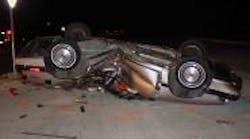“This study highlights the magnitude of the problem of crash-related injuries from a cost perspective, and the numbers are staggering.” –Dr. Grant Baldwin, director of the Centers for Disease Control and Prevention’s division of unintentional injury prevention
Think on this number for a minute: $99 billion. That’s the cost of medical care and productivity losses associated with injuries from motor vehicle crashes in just a one-year period, according to a new study by the Centers for Disease Control and Prevention (CDC).
That roughly equates to a $500 yearly bill for each licensed driver in the U.S., the study found.
Now, the CDC’s researches used 2005 data for this research because it provided the most current source of national fatal and non-fatal injury and cost data from multiple sources.
Still, even with the five-year time lag in mind, the numbers still paint a shocking picture to say the least.
The one-year costs of fatal and non-fatal crash-related injuries segmented by type totaled $70 billion (71% of total costs) for people riding in motor vehicles, such as cars and light trucks; some $12 billion for motorcyclists; $10 billion for pedestrians; and $5 billion for bicyclists, according to the CDC’s analysis.
Here are some other despairing factoids:
• Costs related to fatal motor vehicle-related injuries totaled $58 billion. The cost of non-fatal injuries resulting in hospitalization amounted to $28 billion, and the cost of injuries to people treated in emergency departments and released was $14 billion.
• More men were killed (70%) and injured (52%) in motor vehicle crashes than women, with injuries and deaths among men represented 74% (some $74 billion) of all costs.
• Teens and young adults made up 28 percent of all fatal and nonfatal motor vehicle injuries and 31% of the costs ($31 billion) – and young people represent only 14% of the U.S. population.
• Motorcyclists made up 6% of all fatalities and injuries but 12% of the costs, likely due to the severity of their injuries.
• Pedestrians, who have no protection when they are hit by vehicles and are also often severely injured, made up 5% of all injuries but 10% of total costs.
Now, the CDC's Injury Center believes a large portion of the deaths, injuries and related costs of highway crashes can be avoided by refocusing enforcement efforts in several key areas, such as:
• Graduated driver licensing (GDL) policies: these laws allow new teen drivers to get experience on the road in lower-risk situations as they gain experience over time and are proven to reduce teen crashes. Strong GDL laws have been associated with up to 40% decreases in crashes among 16-year-old drivers, the CDC said.
• Child safety seat distribution and education programs: increased use of correctly installed and fitted child safety seats could help reduce the $3.6 billion annual bill for injuries to children, the cost of deaths and injuries determined by this study for this population group.
• Primary seat belt laws: these laws allow motorists to be stopped and cited for not wearing seat belts. Seat belts reduce the risk of death to those riding in the front seat by about half, the CDC noted.
• Enhanced seat belt enforcement programs: Enhanced enforcement programs in which law enforcement officers focus on getting people to buckle up (e.g.: Click It or Ticket), are effective at increasing safety belt use and reducing deaths and injuries, the agency pointed out.
• Motorcycle and bicycle helmet laws: helmets can reduce the risk of death in a motorcycle crash by more than one-third and reduce the risk of brain injury by 69%.
• Sobriety checkpoints: these checkpoints, where drivers are stopped to assess their level of alcohol impairment, can reduce alcohol-related crash deaths by more than 20%.
However, it should be noted here that trucking is doing its part to improve the overall safety picture on our roadways.
For starters, according to data from the National Highway Traffic Safety Administration (NHTSA), large truck fatalities declined to 4,808 in 2007 – the lowest large truck fatality rate since 1992, and a 4.4% decrease from 2006.
Fatalities in large truck crashes also dropped for three years in a row, from 5,240 in 2005 to 4,808 in 2007, a total decline of 8.2%. Injuries are down as well, dropping to 101,000 in 2007 – a 4.7% reduction since 2006 and a big decline from a peak of 142,000 injuries in 1999.
Now let’s turn to seat-belt usage among commercial drivers. The Federal Motor Carrier Safety Administration (FMCSA) reported that overall safety belt use by commercial drivers climbed to 74% in 2009 from 65% in 2007, with seat belt use at 78% in states with primary safety belt laws – allowing law enforcement to stop drivers for not using a safety belt – versus 67% in states with weaker laws.
The agency’s study also found that national and regional fleet drivers showed a 78% use rate compared to owner-operators, whose usage rate was 64%. More importantly, overall seat belt use among commercial drivers of all types has jumped dramatically in a very short time – from 48% in 2004 and 2005 to over 74% today.
“This is significant because, if you look at truck driver fatalities in highway crashes, a large portion of them weren’t wearing their seat belts,” explained Steve Keppler, executive director for the Commercial Vehicle Safety Alliance (CVSA).
“That seat belt usage rate not only directly impacts the number of lives saved on the highways, it also gives drivers a better opportunity to stay in control of the vehicle and perhaps reduce the severity of a crash – though that benefit is very difficult to quantify,” he stressed.
It also highlights, I believe, the willingness among commercial drivers to change behaviors behind the wheel in order to protect themselves and the other motorists around them on the highways. Something we should not forget as the debate continues on about how to lower the fatalities, injuries, and related costs of vehicle crashes.







